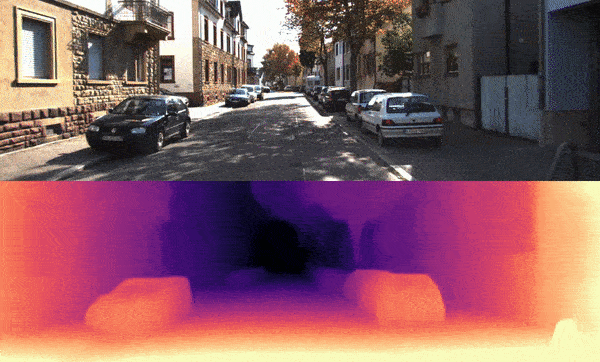Note
Click here to download the full example code
02. Predict depth from an image sequence or a video with pre-trained Monodepth2 models¶
This article will demonstrate how to estimate depth from your image sequence or video stream.
Please follow the installation guide to install MXNet and GluonCV if not yet.
First, import the necessary modules.
import os
import argparse
import time
import PIL.Image as pil
import numpy as np
import mxnet as mx
from mxnet.gluon.data.vision import transforms
import gluoncv
from gluoncv.model_zoo.monodepthv2.layers import disp_to_depth
import matplotlib as mpl
import matplotlib.cm as cm
import cv2
# using cpu
ctx = mx.cpu(0)
Prepare the data¶
In this tutorial, we use one sequence of KITTI RAW datasets as an example. Because the KITTI RAW dataset only provides image sequences, the input format is image sequences in this tutorial.
Follow the command to download example data:
cd ~/.mxnet/datasets/kitti/examples
wget https://s3.eu-central-1.amazonaws.com/avg-kitti/raw_data/2011_09_26_drive_0095/2011_09_26_drive_0095_sync.zip
unzip 2011_09_26_drive_0095_sync.zip
After getting the dataset, we can easily load images with PIL.
data_path = os.path.expanduser("~/.mxnet/datasets/kitti/example/2011_09_26/2011_09_26_drive_0095_sync/image_02/data")
files = os.listdir(os.path.expanduser(data_path))
files.sort()
raw_img_sequences = []
for file in files:
file = os.path.join(data_path, file)
img = pil.open(file).convert('RGB')
raw_img_sequences.append(img)
original_width, original_height = raw_img_sequences[0].size
Loading the model¶
In this tutorial we feed frames from the image sequences into a depth estimation model, then we could get the depth map of the input frame.
For the model, we use monodepth2_resnet18_kitti_mono_stereo_640x192 as it is accurate and
could recover the scaling factor of stereo baseline.
Out:
Downloading /root/.mxnet/models/monodepth2_resnet18_kitti_mono_stereo_640x192-9515c219.zip from https://apache-mxnet.s3-accelerate.dualstack.amazonaws.com/gluon/models/monodepth2_resnet18_kitti_mono_stereo_640x192-9515c219.zip...
0%| | 0/70343 [00:00<?, ?KB/s]
0%| | 101/70343 [00:00<01:21, 858.14KB/s]
1%| | 515/70343 [00:00<00:28, 2419.21KB/s]
3%|3 | 2181/70343 [00:00<00:08, 7736.56KB/s]
12%|#1 | 8202/70343 [00:00<00:02, 26380.50KB/s]
21%|##1 | 14992/70343 [00:00<00:01, 40358.57KB/s]
32%|###1 | 22197/70343 [00:00<00:00, 50649.36KB/s]
44%|####4 | 31151/70343 [00:00<00:00, 62972.78KB/s]
56%|#####5 | 39274/70343 [00:00<00:00, 68660.36KB/s]
68%|######7 | 47647/70343 [00:00<00:00, 73301.38KB/s]
80%|######## | 56595/70343 [00:01<00:00, 78242.36KB/s]
92%|#########1| 64492/70343 [00:01<00:00, 78066.28KB/s]
70344KB [00:01, 57446.53KB/s]
Prediction loop¶
For each frame, we perform the following steps:
loading a frame from the image sequence
pre-process the image
estimate the disparity for the image
transfer the disparity to a depth map
store the depth map to the prediction sequence
min_depth = 0.1
max_depth = 100
# while use stereo or mono+stereo model, we could get real depth value
scale_factor = 5.4
MIN_DEPTH = 1e-3
MAX_DEPTH = 80
feed_height = 192
feed_width = 640
pred_depth_sequences = []
pred_disp_sequences = []
for img in raw_img_sequences:
img = img.resize((feed_width, feed_height), pil.LANCZOS)
img = transforms.ToTensor()(mx.nd.array(img)).expand_dims(0).as_in_context(context=ctx)
outputs = model.predict(img)
mx.nd.waitall()
pred_disp, _ = disp_to_depth(outputs[("disp", 0)], min_depth, max_depth)
t = time.time()
pred_disp = pred_disp.squeeze().as_in_context(mx.cpu()).asnumpy()
pred_disp = cv2.resize(src=pred_disp, dsize=(original_width, original_height))
pred_disp_sequences.append(pred_disp)
pred_depth = 1 / pred_disp
pred_depth *= scale_factor
pred_depth[pred_depth < MIN_DEPTH] = MIN_DEPTH
pred_depth[pred_depth > MAX_DEPTH] = MAX_DEPTH
pred_depth_sequences.append(pred_depth)
Store results¶
Here, we provide an example of storing the prediction results. Including:
store depth map
output_path = os.path.join(os.path.expanduser("."), "tmp")
pred_path = os.path.join(output_path, 'pred')
if not os.path.exists(pred_path):
os.makedirs(pred_path)
for pred, file in zip(pred_depth_sequences, files):
pred_out_file = os.path.join(pred_path, file)
cv2.imwrite(pred_out_file, pred)
store disparity and save it to a video
rgb_path = os.path.join(output_path, 'rgb')
if not os.path.exists(rgb_path):
os.makedirs(rgb_path)
output_sequences = []
for raw_img, pred, file in zip(raw_img_sequences, pred_disp_sequences, files):
vmax = np.percentile(pred, 95)
normalizer = mpl.colors.Normalize(vmin=pred.min(), vmax=vmax)
mapper = cm.ScalarMappable(norm=normalizer, cmap='magma')
colormapped_im = (mapper.to_rgba(pred)[:, :, :3] * 255).astype(np.uint8)
im = pil.fromarray(colormapped_im)
raw_img = np.array(raw_img)
pred = np.array(im)
output = np.concatenate((raw_img, pred), axis=0)
output_sequences.append(output)
pred_out_file = os.path.join(rgb_path, file)
cv2.imwrite(pred_out_file, cv2.cvtColor(pred, cv2.COLOR_RGB2BGR))
width = int(output_sequences[0].shape[1] + 0.5)
height = int(output_sequences[0].shape[0] + 0.5)
fourcc = cv2.VideoWriter_fourcc(*'mp4v')
out = cv2.VideoWriter(
os.path.join(output_path, 'demo.mp4'), fourcc, 20.0, (width, height))
for frame in output_sequences:
frame = cv2.cvtColor(frame, cv2.COLOR_RGB2BGR)
out.write(frame)
# uncomment to display the frames
# cv2.imshow('demo', frame)
# if cv2.waitKey(25) & 0xFF == ord('q'):
# break
We release the webcam before exiting:
out.release()
# cv2.destroyAllWindows()
The result video for the example:

You can start with the example code.¶
Download the script to run the demo
This example command will load an image sequence then store a video:
This example command will load an image sequence then store the corresponding colorized disparity sequence:
For more demo command options, please run python demo.py -h
Hint
This tutorial directly loads the image sequence or video into a list, so it cannot work when the image sequence or video is large. Here is just provide an example about using a pretrained monodepth2 model to do a prediction for users.
Total running time of the script: ( 0 minutes 56.825 seconds)